What Role Did Quran Play on Islamic Art and Architecture in Muslim World
Islamic art is the term used to depict the broader art forms that occurred in Islam after the 7th century CE. It was not restricted to only Muslim artists making religious artworks, simply all art forms and non-Muslim artists under this designating term. This article volition explore Islam art, its characteristics, as well equally some of the common art forms from this extensive creative and cultural menses in the Islamic world.
Table of Contents
- ane Introducing Islam: A Chronological Overview
- 1.i Early Flow
- 1.2 Medieval Period
- 1.3 Later Period
- ii What Is Islamic Fine art?
- 2.1 Islamic Art Characteristics
- 2.2 Islamic Calligraphy Art
- 2.3 Islamic Architecture
- 2.4 Other Islamic Art Forms
- iii Islamic Art: From the Past to the Present
- iv Frequently Asked Questions
- 4.1 What Is Islamic Fine art?
- 4.ii What Are the Characteristics of Islamic Fine art?
- iv.3 When Did Islamic Fine art Occur?
Introducing Islam: A Chronological Overview
Information technology was just during the nineteenth century CE when the "umbrella" term, Islamic art, was used to describe the cultural material from the vast regions of Islam, spanning well-nigh 1400 years. Therefore, it is important that when nosotros explore Islam art, nosotros must go on in mind that it includes numerous art forms and artists from numerous regions and socio-political structures like kingdoms and dynasties.
To understand Islam fine art, let us briefly explore how it originated, and what the Islamic religion is.
The Islamic faith is one of the world's largest proficient monotheistic religions alongside Christianity and Judaism (all of which are also called "Abrahamic faiths" because they share similar relationships with the prophet Abraham).
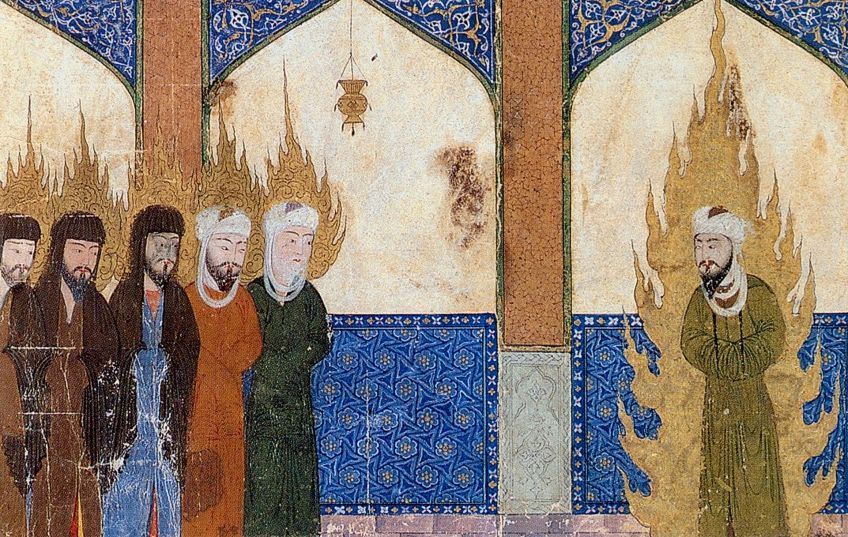 Medieval Persian manuscript depicting Muhammad leading Abraham, Moses, and Jesus in prayer;Unknown writer Unknown author, Public domain, via Wikimedia Commons
Medieval Persian manuscript depicting Muhammad leading Abraham, Moses, and Jesus in prayer;Unknown writer Unknown author, Public domain, via Wikimedia Commons
The beginnings of the Islamic religion lie with the prophet Muhammad, who was the founder of the religion, and its seminal religious text, the Qur'an, which was written from the prophet's recitations after his religious revelations. The Arabian metropolis, Mecca, is where Mohammad is believed to have been born, and is considered a sacred and holy city.
Islamic fine art can exist divided into iii chronological time periods for easier agreement and context. This includes the Early menstruum, from effectually 640 to 900 CE, the Medieval menses, from around 900 to 1517 CE, and the final, or Afterward period, which was from around 1517 to 1924 CE.
Below, we wait at each time period and the prevailing dynasties and other ruling structures within each.
Early on Menstruum
The Early period in Islam's socio-political history and art is estimated to be effectually 640 to 900 CE. This falls just after Mohammad's decease, which was in the year 632 CE. After Mohammad'southward death, 4 Caliphs were appointed as his successors, known equally the "Rightly Guided Caliphs" – Caliphs are rulers within what is known every bit the caliphate, which is a land under Islamic rule.
The word "caliph" originates from the Arabic word "Khalifa", which means "successor".
These 4 Caliphs include the commencement, Abu Bakr, who ruled from 632 to 634 CE; Omar (or Umar), who reigned from 634 to 644 CE; Uthman ibn Affan, who reigned from 644 to 656 CE; and Ali ibn Abi Talib, who reigned from 656 to 661 CE. There was a fifth Caliph, Al-Hasan ibn Ali ibn Abi Talib, but he reigned simply for a few months and is not as prominent as the abovementioned iv.
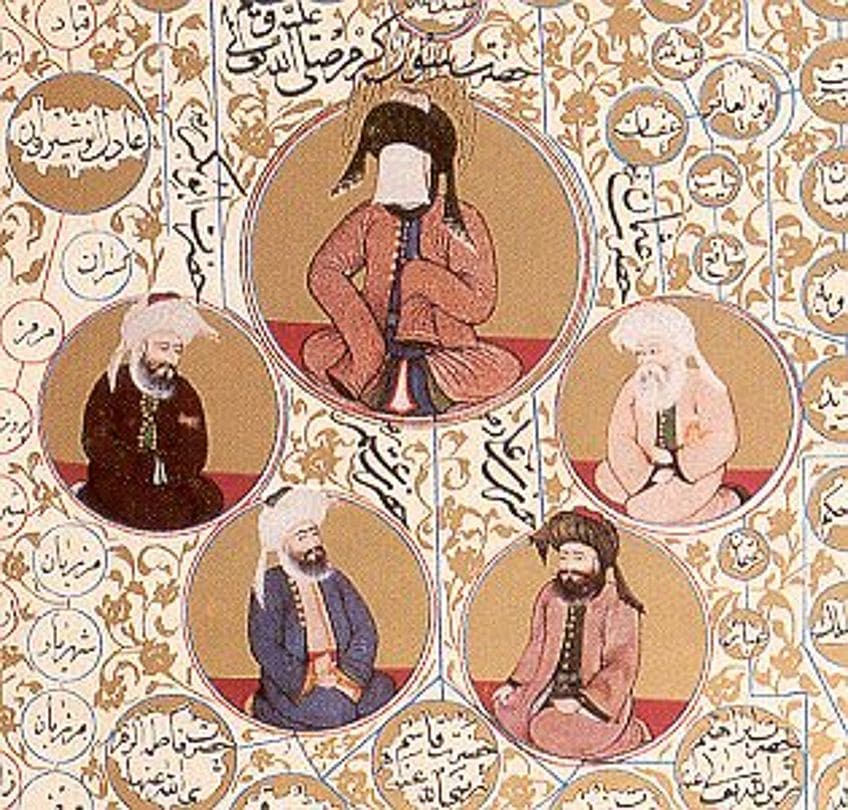 Mohammed (top, veiled) and the first 4 Caliphs, from the Subhat al-Akhbar;Unknown author Unknown author, Public domain, via Wikimedia Commons
Mohammed (top, veiled) and the first 4 Caliphs, from the Subhat al-Akhbar;Unknown author Unknown author, Public domain, via Wikimedia Commons
During this period, at that place was political unrest over the successors, and Uthman ibn Affan and Ali ibn Abi Talib were assassinated by rebels and sects who protested for new Caliphs. This is when the start civil war (often also known every bit the "Start Fitna") started, which occurred while Ali ibn Abi Talib reigned. Later on his assassination, the Umayyad Dynasty started, based in Damascus, Syria.
This was also when the 5th caliph, Al-Hasan ibn Ali ibn Abi Talib, signed a peace treaty for the caliph Mu'awiya to rule. The Umayyad Dynasty ruled from around 661 to 750 CE, and the second civil war ("Second Fitna") started afterwards Mu'awiya'southward death in the twelvemonth 780 CE.
The Abbasid Dynasty ruled after the Umayyad Dynasty.
This new dynasty was founded by Abbas ibn Abdul-Muttalib after the Abbasid Revolution in 750 CE. The Abbasid Dynasty ruled in Baghdad, which was founded past Al-Mansur, the second Abbasid Caliph (this was after they ruled in Kufa, Iraq). Eventually, the dynasty was taken over in 1258 CE by the Mongol Empire.
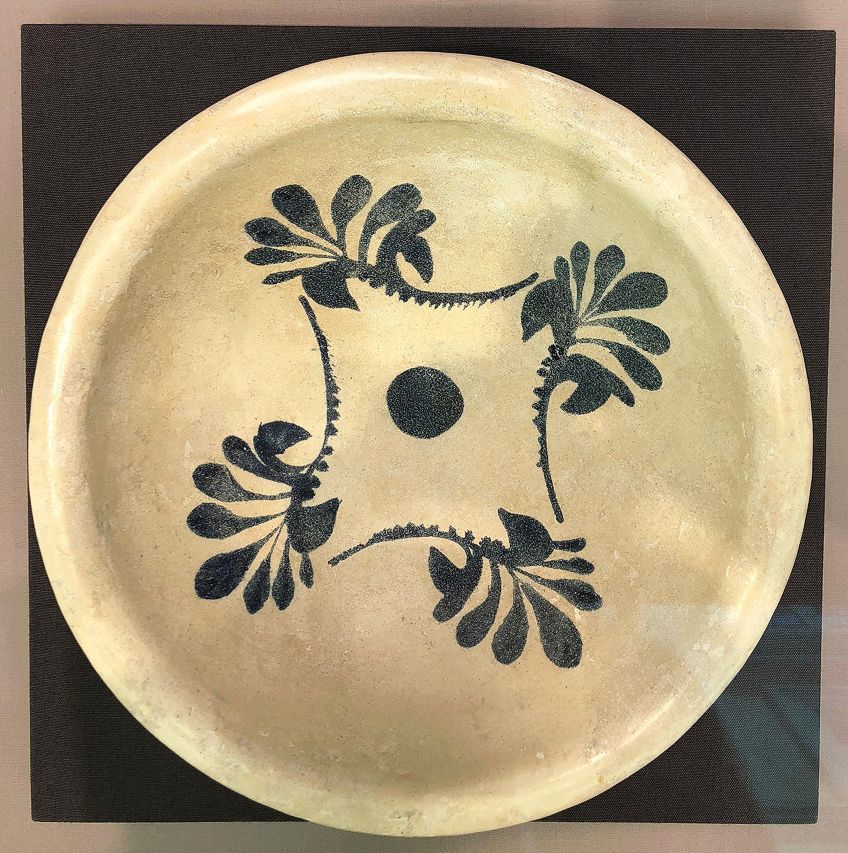 Abbasid 9th-century stoneware, probably from the 830s, from a Tang shipwreck of that decade;Bjoertvedt, CC BY-SA 4.0, via Wikimedia Commons
Abbasid 9th-century stoneware, probably from the 830s, from a Tang shipwreck of that decade;Bjoertvedt, CC BY-SA 4.0, via Wikimedia Commons
The Abbasid Dynasty was likewise known as the "Islamic Gilded Age" equally it became a cultural and intellectual centre in diverse disciplines like science, engineering science, theology, literature, visual arts, music, among others. In that location was also a cross-cultural influence between the East (such as China, India, Iran) and the Westward (for example, Europe's Byzantine and Classical Antiquity styles).
This is besides where Islamic art began to flourish, creating pottery, ceramics (especially what is known by luster-ware), wood, stone, textiles, and various other creative modalities. The art during this period as well contributed to how Islam art would eventually develop over time.
Medieval Catamenia
The Medieval menses started around the 900s CE and lasted until well-nigh the 1500s CE. Equally the Abbasid Dynasty concluded, at that place were several new dynasties in North Africa and the East. This started with the Fatimid Dynasty, which began around 909 to 1171 CE. The Fatimids Mohammad's girl's name, which was Fatima.
During this menstruation, the Fatimids ruled in Egypt and Syria, with Cairo every bit the main city.
This besides became a cultural centre with a trade route in the Mediterranean and the Indian oceans. There was likewise a focus on building architectural structures like Mosques, which were important religious structures. Some prominent examples include the Al-Hakim and Al-Azhar Mosques in Cairo.
Other forms of art that emerged from the Fatimid Dynasty included ceramics and pottery, relief sculptures, and carvings made from ivory. There was as well a focus on decorative patterns on objects, such as foliage (otherwise referred to as "vegetal" forms) and human shapes. The Fatimid Dynasty produced its art in a luxurious manner.
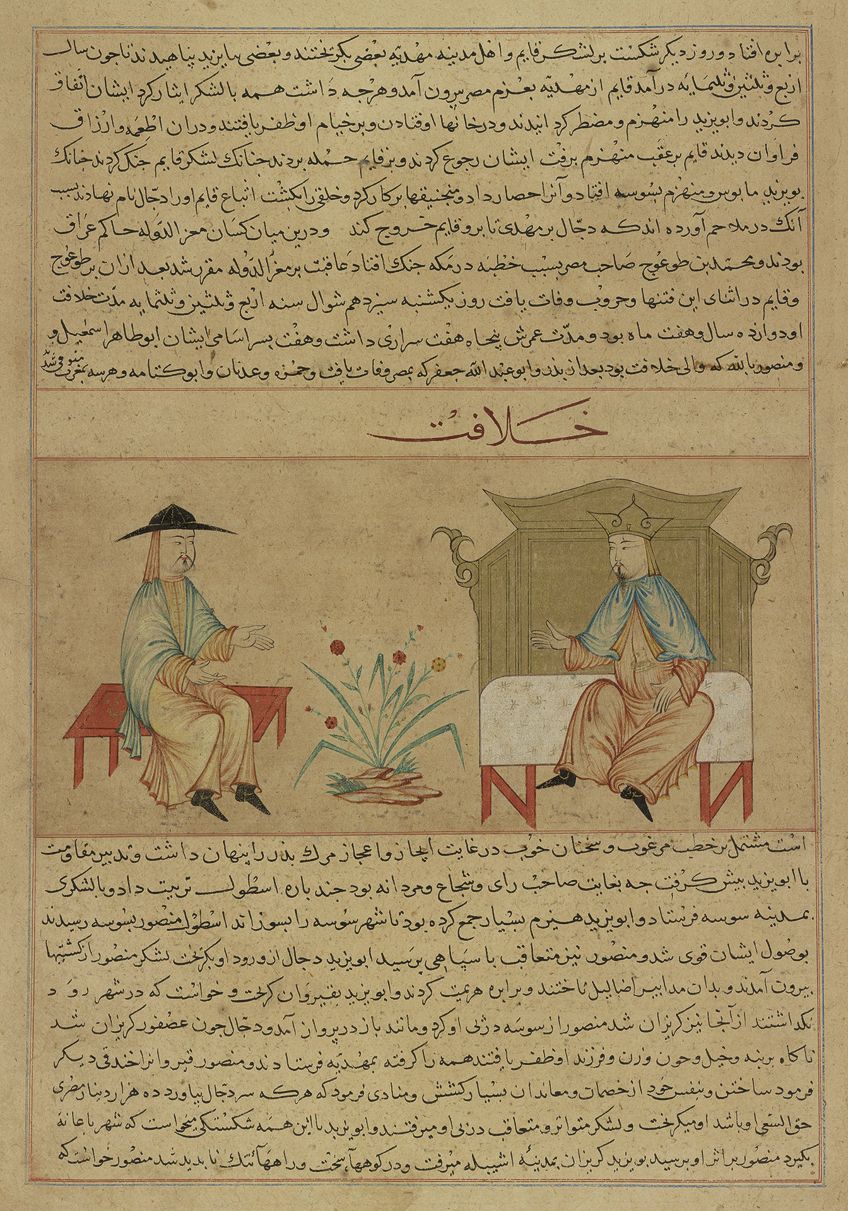 Mansur, Fatimid Caliph of Egypt, from a manuscript of Hafiz-i Abru'south Majma' al-tawarikh (c. 1425);Yale University Art Gallery, Public domain, via Wikimedia Eatables
Mansur, Fatimid Caliph of Egypt, from a manuscript of Hafiz-i Abru'south Majma' al-tawarikh (c. 1425);Yale University Art Gallery, Public domain, via Wikimedia Eatables
Subsequently the Fatimid Dynasty came the Ayyubids, who reigned from 1171 to 1250. Other dynasties included the Ghaznavids, who ruled from 977 to 1186 CE, who were Turkish in origin. The Seljuk Empire, also Turkish, ruled around the years 1038 to 1194 CE. The Seljuks consisted of a strong military force and ruled in areas like Iran, Iraq, Syrian arab republic, and Turkey.
The Seljuks made significant contributions to the development of civilization, art, and politics. They also invested in the development of education through schools, called "madrasas" in Arabic.
Some of the more notable architectural inclusions from this period include the four-iwan layout for congregational mosques, consisting of four doorways on each side of a rectangular building or courtyard. A famous example of such a building is the Masjid-e Jameh, or the Corking Mosque of Isfahan, which was built past the Malik Shah. Other creative developments included ceramics, metalwork, textiles, and more. Some of the techniques in ceramics included fritware.
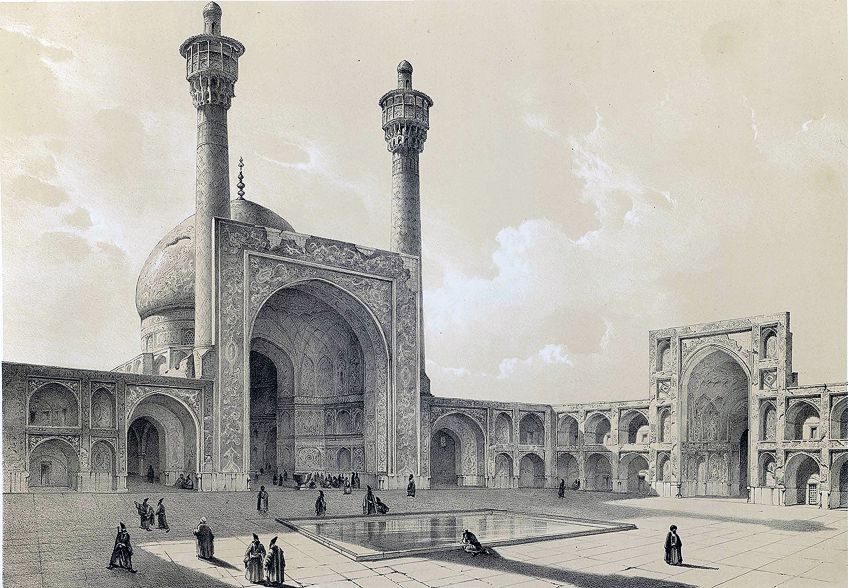 A drawing of the courtyard of the Jama Mosque, Isfahan by Eugène Flandin, 1840;Eugène Flandin, Public domain, via Wikimedia Commons
A drawing of the courtyard of the Jama Mosque, Isfahan by Eugène Flandin, 1840;Eugène Flandin, Public domain, via Wikimedia Commons
The Mamluks reigned from around 1250 to 1517 CE and were mainly based in Cairo, Egypt, Syria, and other areas in the Middle Eastward. The Mamluks were freed slaves or slave soldiers from diverse cultures, peculiarly Turkic slaves. The Arabic word mamluks ways "owned" or "one who is endemic".
During the Mamluk rule, in that location was also a surge in Islamic art and architecture, peculiarly with the intention to emphasize the grandiosity of the rulers. Cairo was one of the cultural and artistic centers at the fourth dimension and showcased the rich and elaborate expressions of Muslim art. Buildings included mosques, schools, and mausoleums, among others.
Other forms of art and craft included metalwork and glasswork.
Ceramics besides showed influence from Eastern cultures like the Chinese due to the all-encompassing trade routes, which allowed a wider reach. An example of elaborate craftsmanship is the metal bowl, Baptistere de Saint Louis (1290 to 1310).
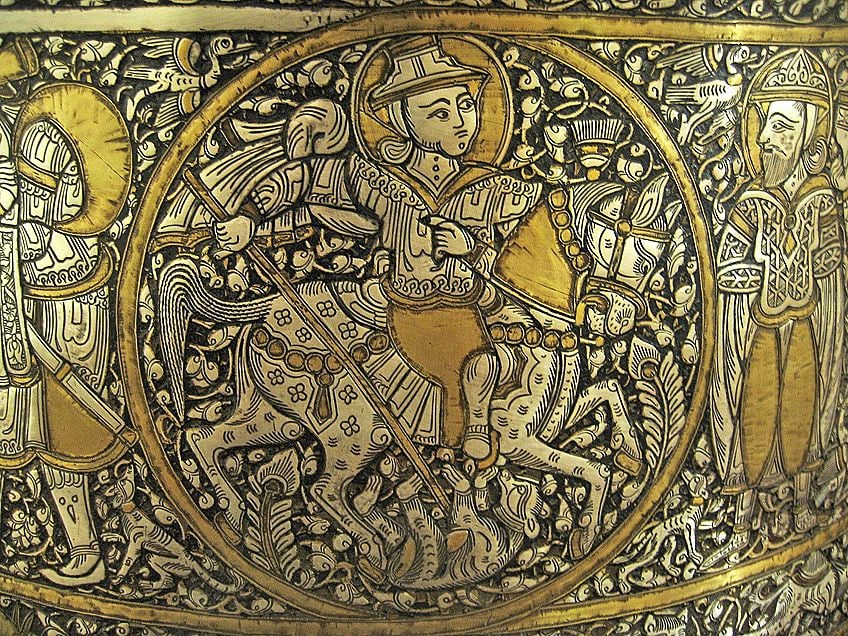 Baptistère de saint Louis (between c. 1320 and c. 1340) past Mohammed ibn al-Zain. Basin with a procession of officials and four riders in roundels (outside band) and friezes of animals and coats-of-artillery (interior band); Louvre Museum, Public domain, via Wikimedia Commons
Baptistère de saint Louis (between c. 1320 and c. 1340) past Mohammed ibn al-Zain. Basin with a procession of officials and four riders in roundels (outside band) and friezes of animals and coats-of-artillery (interior band); Louvre Museum, Public domain, via Wikimedia Commons
Subsequently Period
The Ottomans started to overrule the Mamluks, reigning from around 1281 to 1924. This introduces the Later on period in Islamic history, equally well as Islamic art and architecture, amid other arts and crafts. The Later period includes several important dynasties and empires, notably the Ottoman Empire; the Timurids, who reigned from effectually 1369 to 1502; the Safavids, who reigned from around 1502 to 1736; and the Mughals, who reigned from effectually 1526 to 1858.
The Ottomans took command over the Byzantine empire's city, Constantinople, in 1453, which and so became Istanbul. With their rule, they introduced impressive architectural structures. Architects also utilized the Byzantine-style dome in building layouts. Other forms of Muslim art included ceramics and decorative arts, especially the Iznik pottery fashion.
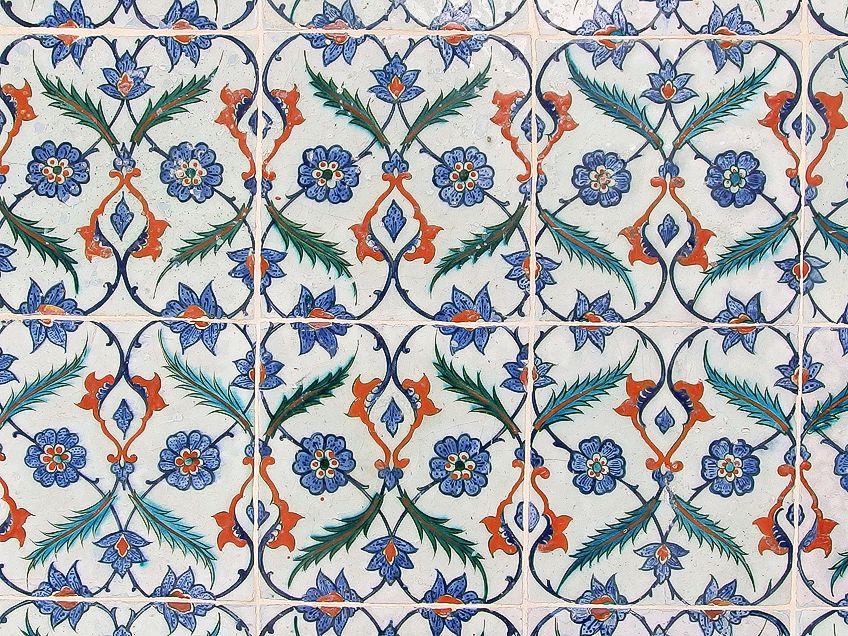 Ceramic tiles in the Iznik style, Topkapı Palace, 18th century;Marker Ahsmann, CC By-SA 3.0, via Wikimedia Commons
Ceramic tiles in the Iznik style, Topkapı Palace, 18th century;Marker Ahsmann, CC By-SA 3.0, via Wikimedia Commons
The Iznik manner was prominent on tiles and was characterized by flowers and vines in curvilinear shapes. The colors consisted of different hues of blues and turquoise. There was also an extensive production of textiles too as the extensive utilise of calligraphy, which was an important role of Islam fine art. Some prominent examples include the Topkapı Palace (structure started in 1459) and the Süleymaniye Mosque (1550 to 1558).
When we await at the Timurids and Safavids, both empires included impressive architectural structures.
The Timurids developed elaborately decorated buildings, many examples of which can be establish in the city Samarkand, which became the majuscule metropolis under Timur's dominion. He further expanded this city with the help of numerous artists, architects, and craftsmen. The chief objective was to make it a "pearl of the world", glistening with colors like golds and hues of blue.
The Safavids too produced high-quality manuscripts, especially illuminated manuscripts. Islamic painting through this course of art was exceedingly popular, and a pregnant number of patrons came from the purple court. An instance tin can be seen in the Shahnama, which was a "Book of Kings".
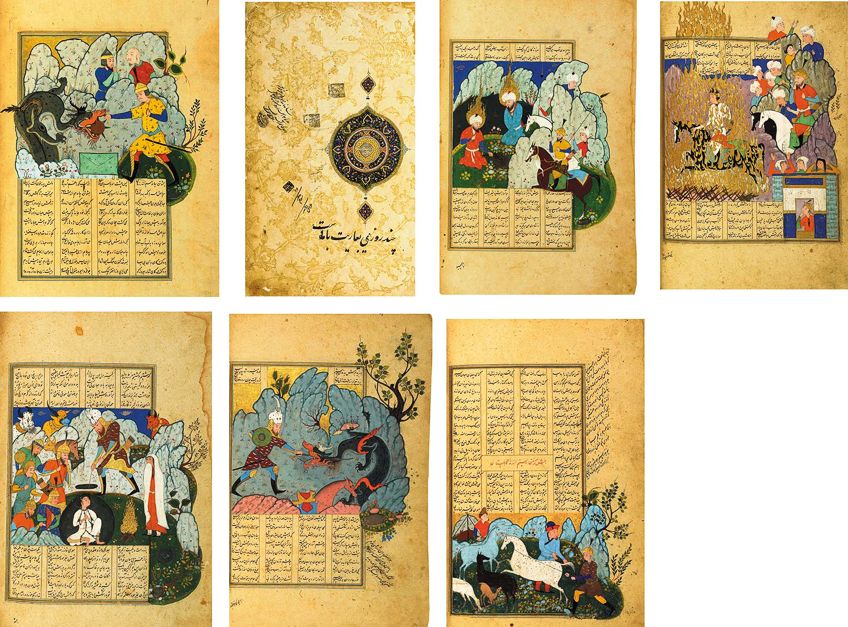 Pages from an illustrated manuscript of the Shah Namah that may have belonged to Jahangir, c. 1570;Come across page for author, Public domain, via Wikimedia Commons
Pages from an illustrated manuscript of the Shah Namah that may have belonged to Jahangir, c. 1570;Come across page for author, Public domain, via Wikimedia Commons
Other forms of art included textiles, especially in the form of Farsi carpets, which were utilized in the courts, such as theArdabil Carpet (1539 to 1540). The entire carpet appears elaborately decorated with forms of foliage, flowers, and other patterns.
The Mughal Empire was founded by the chieftain Babur, who was a descendent of Timur and Genghis Khan, the first emperor of the Mongol Empire.
The Mughal Empire extended its achieve into India. Artwork spanned across painting, architecture, illuminated manuscripts, and more. This period likewise includes the construction of famous building, the Taj Mahal (1632 to 1653), deputed to be built by Shah Jahan, who was the fifth Mughal Emperor.
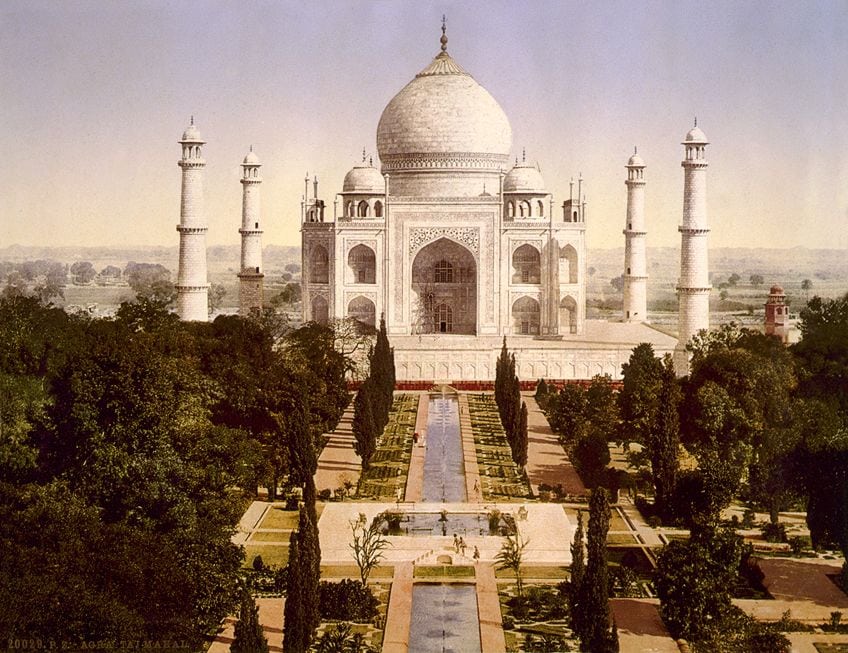 A photograph of the Taj Mahal, Agra, Republic of india, c. 1900;Detroit Publishing Co., under license from Photoglob Zürich, Public domain, via Wikimedia Commons
A photograph of the Taj Mahal, Agra, Republic of india, c. 1900;Detroit Publishing Co., under license from Photoglob Zürich, Public domain, via Wikimedia Commons
What Is Islamic Art?
While there were numerous Islamic dynasties and empires throughout Islamic history, the art of each menstruum evolved and developed according to individual regions also as the overlapping of these different ruling dynasties and empires. Below, nosotros look at some of the common Islamic art characteristics and the prevalent themes recurring throughout.
We will await at various Islam fine art modalities like painting, architecture, the importance of Islam calligraphy art, and more.
Islamic Art Characteristics
Islamic art and architecture tend to be characterized by the shared commonality that is the Islamic religion. The veneration of the Islamic faith and its traditions underpin almost all of Islam art with the primary holy text, the Qur'an, serving every bit a guidepost for Muslim artists. So, with that in mind, when we look at Islam fine art, we tin understand what drove and inspired Muslim artists to create their works.
It is also important to note the dissimilar religious practices within the Islam faith, equally these also had a place within many buildings and objects used to facilitate religious expression.
 The Five Pillars of Islam;Xxedcxx, CC BY 3.0, via Wikimedia Commons
The Five Pillars of Islam;Xxedcxx, CC BY 3.0, via Wikimedia Commons
These buildings and objects now fall nether the scope of Islamic fine art and compages. Some of the Islamic practices include the important "Five Pillars of Islam" (or Arkān). These are, namely, the Shahada (Profession of Faith), the Salah (Prayer), Zakat (Almsgiving), Sawm (Fasting), and the terminal, Hajj (Pilgrimage).
Practitioners of the Islamic religion were required to adhere to these practices. The starting time practice, for instance, the Shahada, involves the cadre belief or tenet that "at that place is no god but God, and Muhammad is the Messenger of God." This is also widely seen inscribed in Islamic art and architecture.
This also emphasized the close link between the fine art grade and the proclamation of one's religious beliefs. Islamic art like paintings and architecture acted every bit vehicles for religious and sacred expressions, which and so begs the question of whether the label as "art" merely came afterward through art historical inquiry.
Arabesques
Other characteristics include the highly busy patterns and Islamic motifs, including geometric and floral shapes done in various patterns. The geometric Islamic motifs concur significant symbolism related to God and transcending life, symbolizing the infinite.
These geometric patterns are as well referred to every bit Arabesques and are seen far and wide on many buildings.
 The Arabesque walls and architecture of the Alhambra;FrDr, CC Past-SA 4.0, via Wikimedia Eatables
The Arabesque walls and architecture of the Alhambra;FrDr, CC Past-SA 4.0, via Wikimedia Eatables
Some examples tin be seen as far equally Spain, like the Alhambra (c. 1238 to 1358), which ways "The Red One" in Arabic) too equally many more notable buildings. In that location were likewise three primary types of buildings built, namely: mosques, madrasas (religiously oriented schools), and mausoleums. All of these buildings would be congenital and busy in varying ways.
Another Islamic fine art feature is that only geometric and floral patterns were utilized with no inclusion or portrayal of the homo figure and animals. The human figures were considered idol worship and not considered suitable for depictions in Islam art, which were meant for worshipping purposes.
This is referred to as Aniconism and falls nether the Islamic police force called Sharia Law. In some forms of Islam art, there would be depictions of holy figures like Mohammad and others equally part of telling a story, although the use of more than geometric and floral shapes also calligraphy was more than prevalent.
While Aniconism was a strong part of Islamic art and architecture, in that location are examples where this was non applied.
While the older, more religious spaces subscribed to aniconism, such every bit the shrine in Jerusalem called the Dome of the Rock (c. 7th century CE) and the Al-Aqsa Mosque (completed in 705 CE), other spaces that belonged to sovereigns and their private homes chose to include humans and beast figures. Examples of these include the palace chosen Khirbat Mafjar (c. eightthursday century CE), also known equally Hishām's Palace.
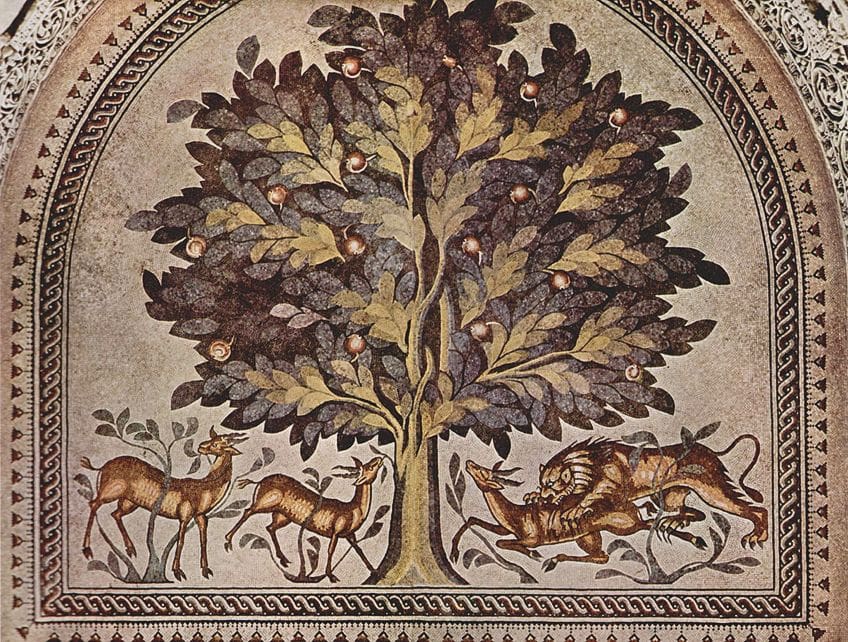 Floor mosaic of the audience room in the bathhouse of Khirbat al-Mafjar, Jordan, 724-743. The scene depicts an apple tree tree with gazelles and king of beasts;Arabischer Mosaizist um 735, Public domain, via Wikimedia Commons
Floor mosaic of the audience room in the bathhouse of Khirbat al-Mafjar, Jordan, 724-743. The scene depicts an apple tree tree with gazelles and king of beasts;Arabischer Mosaizist um 735, Public domain, via Wikimedia Commons
Other examples include the castle Qasr Amra (also called Qusayr 'Amra), which is in Jordan. It houses various frescoes on the walls depicting a variety of scenes like hunting, women, and some animals. There are also other forms of Islam art that portrayed figural depictions, seen on textiles, ceramics, metalwork, and illuminated manuscripts.
Calligraphy
Islam art would not exist complete without mentioning calligraphy. Every bit mentioned earlier, calligraphy played a major role in Islam art and architecture, every bit well equally other forms of Muslim art. Calligraphy was the vehicle through which Muslim artists venerated the written word and letters given by Mohammad in the Qur'an.
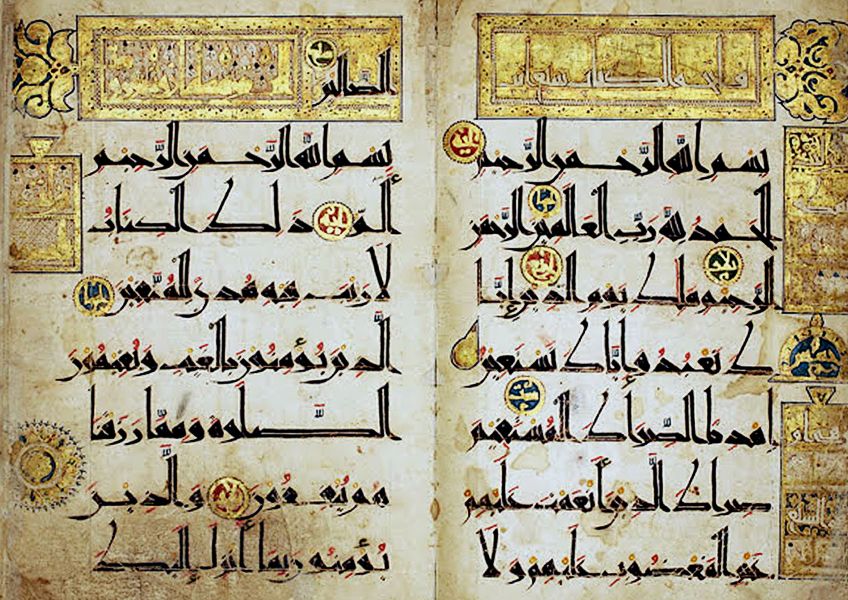 Handwritten Qur'an in Kufic script, from Iran, dating to the after 11th century CE. Co-ordinate to Islamic-Arts.org, "This fragment contains the surah al-Fatihah (the Opening), and al-Baqarah (the Cow). The script is remarkable for its size, each line being roughly iv cm high";Unknown Islamic calligrapher of Islamic republic of iran, later 11th century CE, Public domain, via Wikimedia Commons
Handwritten Qur'an in Kufic script, from Iran, dating to the after 11th century CE. Co-ordinate to Islamic-Arts.org, "This fragment contains the surah al-Fatihah (the Opening), and al-Baqarah (the Cow). The script is remarkable for its size, each line being roughly iv cm high";Unknown Islamic calligrapher of Islamic republic of iran, later 11th century CE, Public domain, via Wikimedia Commons
Where in Christianity in that location was potent visual imagery of religious icons, Muslim art veered more towards the written word beingness painted on surfaces. This served two purposes: to decorate the surface besides as convey the important religious messages from the Qur'an.
Beauty and Meaning
When we wait at Islam art, nosotros will notice a significant focus on ornamentation and lustrous colors similar blues and golds. These colors and designs were also used in common household items like bowls, jewelry, and furniture. Islam art was about a way of life – objects were highly decorated, not simply for the mere sake of art, but also for a deeper significant.
 8-pointed star tile, luster technique, glazed. Ilkhanate period, 2nd one-half of the 13th century CE. From Kashan, Iran;Osama Shukir Muhammed Amin FRCP(Glasg), CC By-SA 4.0, via Wikimedia Commons
8-pointed star tile, luster technique, glazed. Ilkhanate period, 2nd one-half of the 13th century CE. From Kashan, Iran;Osama Shukir Muhammed Amin FRCP(Glasg), CC By-SA 4.0, via Wikimedia Commons
When an object or building had elaborate decorations, the focus was taken off the bodily object and suggested a deeper earth that transcended the material earth. This notion is specially emphasized past the infinity motifs utilized in varying degrees. These Islamic motifs open up and transform the base materials from which the objects or buildings are made into something more beautiful and meaningful.
Islamic Calligraphy Art
When we take a closer look at Islamic calligraphy art, at that place were 2 different calligraphic scripts used, namely, the Kufic script and the Naskhi (or Naskh) script. 1 of the oldest Arabic scripts, the Kufic script originates from Kufa, a city in Iraq, from the Nabatean culture. The appearance of the Kufic script is horizontal, and the letters take an angular depiction when written. In other words, there is a potent verticality that pronounces the messages.
The script's letters are often described equally geometric and linear with vertical and horizontal aspects.
There are also several unlike types of this script, such as the floriated Kufic, which has floral-similar adornments to the messages; the square Kufic, which was used on bricks or tiles in architectural structures that gave the script a block or square-like appearance; the knotted or plaitedKufic, which was used on architectural structures; and the foliated Kufic, which has half-palmettes and "lobed leaves" on the vertical letters. These are only several examples among many other types of the Kufic script.
 The beginning of verse 18 from the 5th chapter of the Qur'an, entitled al-Ma'idah (The Tabular array). The text is executed in a Kufi script at v lines per page in horizontal format. This detail script is differentiated by the upper stroke of the letter kaf (1000) which slants to the right before turning to the left. The text is executed in blackness ink, while cerise dots indicating vox may have been added later on. Diacritical marks also appear to have been added afterward: for example, glottal stops (hamza) are marked in green ink, while duplications of consonants (tashdid) are executed in golden ink, 10th century; Unknown Calligrapher, Public domain, via Wikimedia Commons
The beginning of verse 18 from the 5th chapter of the Qur'an, entitled al-Ma'idah (The Tabular array). The text is executed in a Kufi script at v lines per page in horizontal format. This detail script is differentiated by the upper stroke of the letter kaf (1000) which slants to the right before turning to the left. The text is executed in blackness ink, while cerise dots indicating vox may have been added later on. Diacritical marks also appear to have been added afterward: for example, glottal stops (hamza) are marked in green ink, while duplications of consonants (tashdid) are executed in golden ink, 10th century; Unknown Calligrapher, Public domain, via Wikimedia Commons
The Kufic script was important in that it was used to copy the Qur'an, simply information technology was likewise used for ornamentation purposes on lusterware, drinking glass, coins, architecture, and more than. Some examples of this include many pages taken from different versions of the Qur'an during the viiith to ixth Centuries CE; the Abbassid Qur'an, Persia (late xith to 12th century CE); and ii bowls, one with Kufic inscription (9th century CE) and the other with Kufic calligraphy (10th century CE), both of which are housed in the Brooklyn Museum. Other examples include the golden Fatimid armlet (11th century CE), which is inscribed with a well-meaning bulletin.
The Naskhi script, on the other hand, started replacing the Kufic script during the 11thursday century. Yet, there are scholars that estimate both scripts were utilized centuries before they were given prominence. The Naskhi script is rounder in appearance and by and large used for scribing, whereas the Kufic script was used significantly for decorations of diverse kinds.
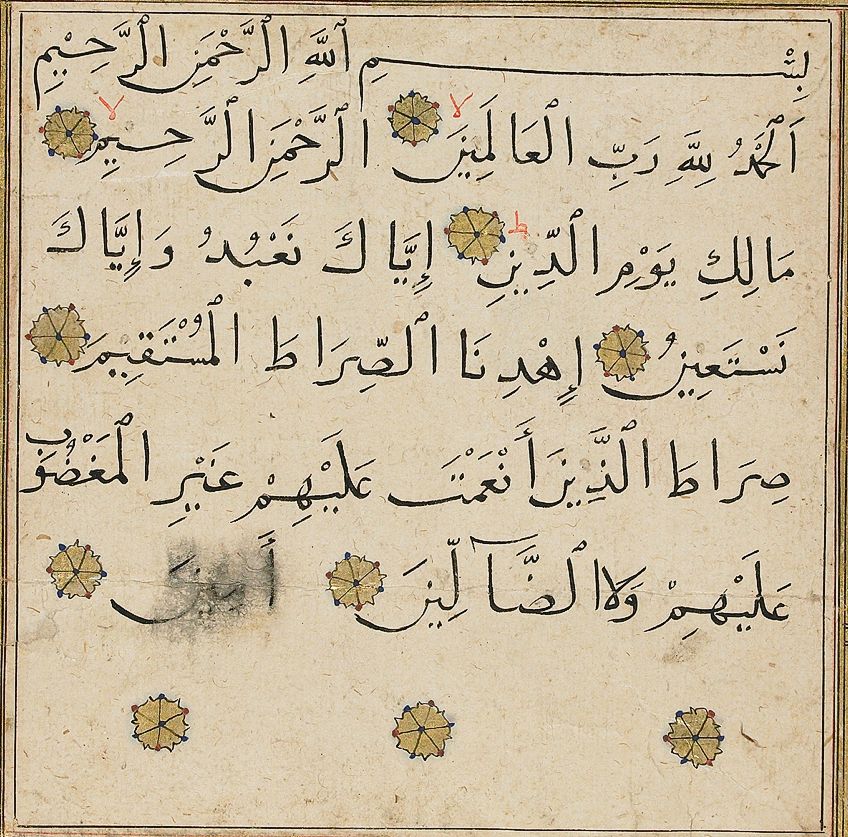 Naskh script: This Qur'anic fragment contains the commencement affiliate of the Qur'an entitled al-Fatihah (The Opening). Recited at the very beginning of the Qur'an, this surah proclaims God every bit Gracious and Merciful, the Master of the Day of Judgment, and the Leader of the straight path. The illuminated upper and lower panels comprise a text, outlined in gilt ink to let the manifestly folio show through, stating that this surah is the opening of the Holy Book (Fatihat al-Kitab al-'Aziz) and contains seven ayahs revealed in Mecca. The text itself is written in the cursive script called Naskh, and each poesy is separated past an ayah marker consisting of a golden six-petalled rosette with blueish and cherry dots on its perimeter. Both the script and the illumination are typical of Qur'ans produced in Mamluk Egypt during the 14th and 15th centuries;Al_Fatihah_-_naskh_script.jpg: Unknown Calligrapherderivative piece of work: Cvereb, Public domain, via Wikimedia Commons
Naskh script: This Qur'anic fragment contains the commencement affiliate of the Qur'an entitled al-Fatihah (The Opening). Recited at the very beginning of the Qur'an, this surah proclaims God every bit Gracious and Merciful, the Master of the Day of Judgment, and the Leader of the straight path. The illuminated upper and lower panels comprise a text, outlined in gilt ink to let the manifestly folio show through, stating that this surah is the opening of the Holy Book (Fatihat al-Kitab al-'Aziz) and contains seven ayahs revealed in Mecca. The text itself is written in the cursive script called Naskh, and each poesy is separated past an ayah marker consisting of a golden six-petalled rosette with blueish and cherry dots on its perimeter. Both the script and the illumination are typical of Qur'ans produced in Mamluk Egypt during the 14th and 15th centuries;Al_Fatihah_-_naskh_script.jpg: Unknown Calligrapherderivative piece of work: Cvereb, Public domain, via Wikimedia Commons
The Naskhi script was mostly used to write administrative documents equally well as to transcribe diverse texts, including the Qur'an. It was easier to read considering it did non have the decorative elements we see from the Kufic script.
An easy way to identify this script is through the lack of "hooks" or pocket-size "lobes" adorning the ends of letters.
Ibn Muqla is known to accept invented the Naskhi script, forth with the cursive text chosen Thuluth and five other scripts called Tawqi', Ruq'ah, Muhaqqaq, and Reyhan. All half dozen scripts are referred to equally the "Half dozen Pens" and vary in style.
Islamic Architecture
The Islamic architectural way can exist seen in the most important construction for Islam, which is the mosque. The mosque in Standard arabic is called masjid. It is a religious building for prayer and praise, although it is also used for community purposes like studying, gatherings, or tranquility reflection.
The mosque is an important construction in the Islamic faith and so besides became an important construction inside Islam art.
Mosque compages is believed to take originated from the first mosque, the Quba Mosque, which was Mohammad'due south home. Information technology was in the mode of an Arabian business firm from the 7th century CE, in Medina, which is now Western Saudi arabia. The Arabian style had a courtyard, rooms, and columns.
 The original Quba Mosque in Medina, built by the prophet Muhammad;Unknown writer Unknown writer, Public domain, via Wikimedia Commons
The original Quba Mosque in Medina, built by the prophet Muhammad;Unknown writer Unknown writer, Public domain, via Wikimedia Commons
The rooms appeared long in their design and were supported past numerous columns, giving the building its classification every bit a hypostyle mosque. The word hypostyle originates from the Greek give-and-take, which ways "under columns", and this was one of the typical styles of mosques for many centuries, a feature common to prayer halls.
There are some overall characteristic features that appear in Mosque architecture, although it is important to understand that Islamic architecture as well varied widely due to the vast geographic expansion, regional styles, and the time it occurred in Islamic history.
One such feature is the Sahn, which is the large courtyard. This is an important part of the Mosque'south prayer hall because of mandatory prayer attendance past all men in the Islam community, meaning that there needs to be enough infinite to firm anybody. There are fountains in the courtyards to offer hydration and cleansing prior to prayer.
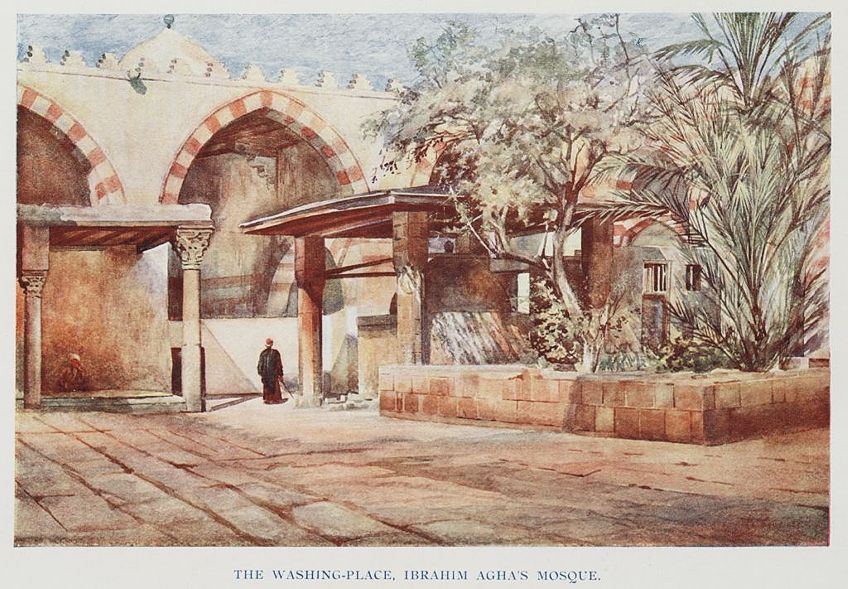 A 1907 painting of the fountain in the interior of Ibrahim Agha'south;Tyrwhitt, Walter Southward.Due south., CC BY-SA 2.5, via Wikimedia Eatables
A 1907 painting of the fountain in the interior of Ibrahim Agha'south;Tyrwhitt, Walter Southward.Due south., CC BY-SA 2.5, via Wikimedia Eatables
The Mihrab, also chosen the qibla wall, is a niche or alcove in the wall that points in the direction of Mecca, which is the direction of prayer. The size of the Mihrab varies in dissimilar Mosques, but it is commonly a smaller, shallower infinite in the wall. An example includes the Mihrab from the Great Mosque in Córdoba (c. 786 CE).
We will also notice the varying decorations that adorn the Mihrabs. Other examples include the Mosque-Madrasa of Sultan Hasan in Cairo (c. 14th century CE); the Jameh Mosque of Isfahan, with aMihrab as a stucco carving of the ruler Uljaytu (14thursday century); the Rüstem Pasha Mosque in Istanbul with Iznik tiles (16th century CE); and known among the largest mosques located in Bharat, the Jama Masjid (c. 17th century CE), which is in Delhi.
 The facade of the Mihrab in the Great Mosque in Córdoba;José Luis Filpo Cabana, CC BY three.0, via Wikimedia Commons
The facade of the Mihrab in the Great Mosque in Córdoba;José Luis Filpo Cabana, CC BY three.0, via Wikimedia Commons
Other common features of Mosque architecture include minarets, which are towers fastened to the mosques serving different functions. Most importantly, these are the sites where the telephone call to prayer is performed. These are as well standing examples of the Islam religion, acting every bit a visual structure that represents the organized religion and culture.
Minarets have different shapes and styles. Some are spiral-shaped, pencil-shaped, or foursquare-shaped, like we see in the Smashing Mosque of Kairouan (ninth century CE). The latter has three different levels that widen as they go down.
Another example is the Minaret of Jam (12th century) in Transitional islamic state of afghanistan. Standing at over 200 feet alpine, it is a round shape with two balconies. It depicts various inscriptions, names, and dates, including the Shahada as decorations effectually it, and is made of brick, stucco, and glazed tile. The minaret appears to be standing alone, however, scholars suggest that information technology was role of the Friday Mosque of Firozkoh, which washed away due to flooding prior to or during the before parts of the 13th century CE.
There are also the pointed minarets from the Sultan Ahmed Mosque (also referred to equally the "Blue Mosque"), congenital in the 17th century CE in Istanbul. This mosque has six minarets that are pencil-shaped and fluted, each with balconies.
 1762 view and floorplan of the Bluish Mosque in Istanbul; Anonymous Unknown writer, Public domain, via Wikimedia Commons
1762 view and floorplan of the Bluish Mosque in Istanbul; Anonymous Unknown writer, Public domain, via Wikimedia Commons
The minaret from the Al-Azhar Mosque (15th century) was located in Cairo, which belonged to Sultan Qaytbay. This was also a large funerary circuitous consisting of the mosque, madrasa, and mausoleum. Along with the minaret, this complex is richly decorated inside and out and is one of the best examples of Egyptian Mamluk architecture.
The dome, meaning Qubba in Arabic, in Mosque compages is some other characteristic. In that location would often be i dome to a structure, although some would accept multiple domes. Domes were significant features for Mosques because they represented the thought of transcendence or sky. The inside of the dome would exist decorated in rich detail, most giving the space a new meaning across the material world.
The Dome of the Stone (seventh century CE) in Jerusalem is considered ane of the starting time domes used in Islamic architecture.
The dome is made from wood and was covered in golden plates during the sixteenthursday century CE. We as well discover the feature bulbous domes on the Süleymaniye Mosque (xvith century CE), which is an Ottoman imperial mosque, the Taj Mahal (17th century CE) in India, also as the Badshahi Mosque (17thursday century CE) in Lahore, Pakistan.
 Diagram of the Dome of the Rock, drawn by Viscount De Vogue in 1864;VICOMTE DE Faddy, Public domain, via Wikimedia Commons
Diagram of the Dome of the Rock, drawn by Viscount De Vogue in 1864;VICOMTE DE Faddy, Public domain, via Wikimedia Commons
Additionally, the domes included the use of vaults to back up the structure inside, such every bit the rib vaulting in the Jameh Mosque of Isfahan (xithursday century) in Iran. The vaulting is described every bit "non-radial" in layout, which was a common feature from the East. Some domes and vaults were likewise decorated with Muqarnas, which is described as resembling "honeycomb" or "stalactites". These are sculpted patterns alongside the ceiling that stand out in varying shapes and sizes.
We will also notice columns and arches in Mosque architecture. Columns varied in size, shape, and textile. Some of the earlier columns included the Classical fashion from Mediterranean areas, appearing smoother and fluted. In countries similar Bharat, columns were made from Indian stone and had square, octagonal, and circular shapes.
Arches also appeared like Roman arches and were more often utilized during the 8th to 10 Centuries CE in Islamic architecture.
 Picture from the von Hallwyl family'south journey through Algeria and Tunisia, 1889-1890. Caption reads: "Tlemcen. Interior of the Great Mosque.";By Unknown author, Public Domain, Link
Picture from the von Hallwyl family'south journey through Algeria and Tunisia, 1889-1890. Caption reads: "Tlemcen. Interior of the Great Mosque.";By Unknown author, Public Domain, Link
The Islamic arches are described by iv distinguishing shapes. The "horseshoe" shape, as well called the "keyhole" shape because of its rounded edges, widens in width most the top of the arch and narrows near the sides. The "pointed" arch shape shares similarities to Gothic architecture and the "ogee" shape appears like the pointed curvation, but it is more stylized; the superlative curve of the arch is more curvilinear (S-shaped) in design and the peak tips encounter from the S-curves. Lastly, the "multifoil" shape appears more "scalloped" in pattern, made by a combination of "foils" in the arched shape.
Other Islamic Fine art Forms
Below, we briefly discuss some of the other modalities that were vehicles for the wide telescopic of Islam art. Aslope Islam calligraphy, art, and architecture, there was a lot of development in Islamic painting, which took on different formats similar miniatures and illuminated manuscripts.
In that location were also Islamic ceramics, pottery, textiles, glasswork, and metalwork.
We will also see the intricate craftsmanship of the Islamic motifs in other forms like leatherwork, jewelry, carvings from semi-precious stones (as well referred to as hardstone carvings) and ivory, dissimilar pieces of furniture and household items, as well equally materials like silk and batik.
 Ilkhanid Medallion, circular slice of silk with Mongol images, Islamic republic of iran or Iraq, early 14th century;David Drove, Public domain, via Wikimedia Commons
Ilkhanid Medallion, circular slice of silk with Mongol images, Islamic republic of iran or Iraq, early 14th century;David Drove, Public domain, via Wikimedia Commons
Islamic Paintings
Islamic paintings included the more famous illuminated manuscripts (book painting) likewise as miniatures. Book paintings were mutual in various regions similar Iraq, the Ottoman Empire, Persia, and Syria. It is believed that this style originated during the 13thursday century CE when the Mongols infiltrated the Islamic culture, and as a result, the Ilkhanid Dynasty is where the first "Farsi books" started.
Illustrated books were unremarkably deputed by the royal courts and aristocrats as they required considerable financial investments to make.
 Islamic painting depicting a hunting scene, c. 1550;Sailko, CC By 3.0, via Wikimedia Commons
Islamic painting depicting a hunting scene, c. 1550;Sailko, CC By 3.0, via Wikimedia Commons
In one case the volume was completed, the Islamic paintings would be done by various artists. The subject area would range from boxing scenes, landscapes, and portraits. On occasion, paintings would be done from Islamic drawings or sketches that were already done and then copied over. Various natural pigments were utilized for Islamic paintings, after which they would exist golden and illuminated.
Islamic miniatures also developed alongside illuminated manuscripts, condign a popular form of Islamic painting.
The miniatures consisted of pocket-sized-scale paintings done on paper and were almost prevalent in the royal courts, equally mentioned in a higher place. We will also notice the common depiction of figural forms and influence from the Byzantine and Chinese eras.
The illustrated books drew extensively from Persian verse, such as from the Shahnameh, which is an epic poem by the Persian called Ferdowsi. There were other stories that revolved effectually historical accounts, autobiographical stories, besides every bit military stories.
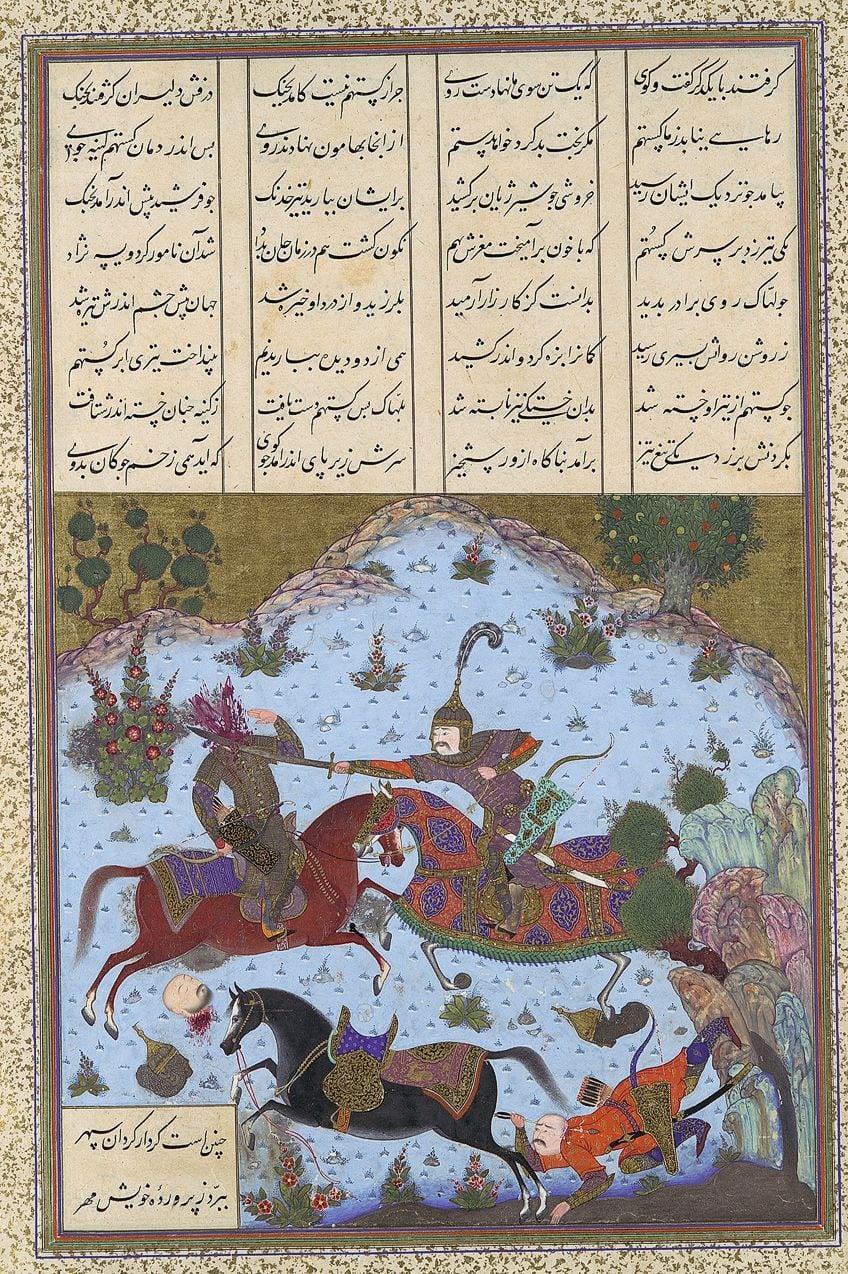 Gustaham Slays Lahhak and Farshidvard (c. 1525-1535), painting attributed to Bashdan Qara;Homaaaa, CC BY-SA 4.0, via Wikimedia Eatables
Gustaham Slays Lahhak and Farshidvard (c. 1525-1535), painting attributed to Bashdan Qara;Homaaaa, CC BY-SA 4.0, via Wikimedia Eatables
Islamic Ceramics
Islamic ceramic art is of import to note here because information technology became one of the most developed forms of Islam fine art and culture compared to other cultures. Information technology took on the forms of pottery and tiles, which adorned many of the architectural structures.
The primeval Islamic pottery was unglazed, but one of the earliest glazing techniques was the tin-opacified glazing. Stonepaste was another technique introduced during the 9th century CE in Iraq.
During the Ottoman rule, Iznik ceramics were a beautiful artform and testament to the Islamic civilisation. Muslim artists drew a lot of influence from Chinese ceramics. However, they were not able to use porcelain due to lack of availability, so Muslim artists created another blazon of pseudo-porcelain, which became known as fritware. It was made from glassy frit, ground quartz crystal, and potter's clay.
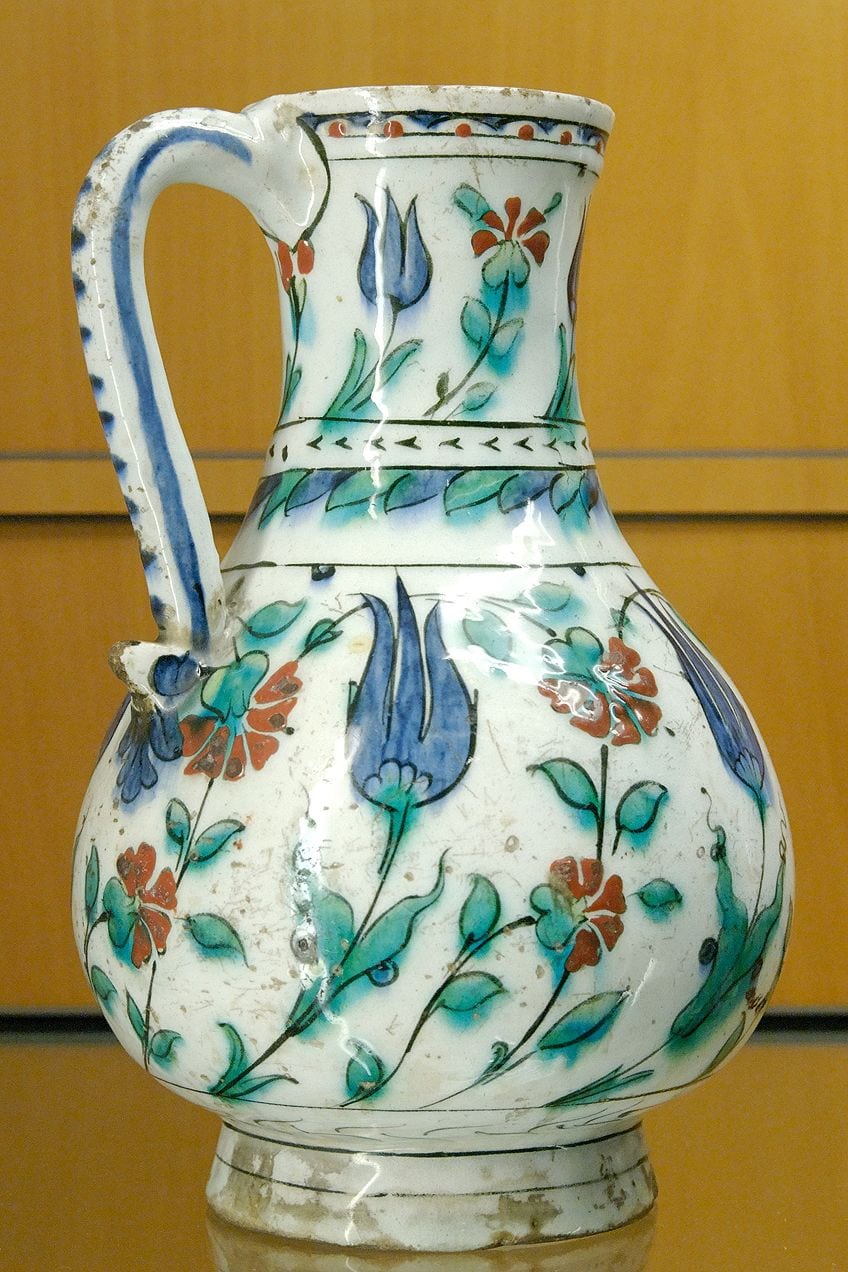 Jug with tulips and carnations. Composite body with underglaze engobe decoration, Iznik, Ottoman Turkey, c. 1590;Museum of Fine Arts of Lyon, CC By 2.5, via Wikimedia Eatables
Jug with tulips and carnations. Composite body with underglaze engobe decoration, Iznik, Ottoman Turkey, c. 1590;Museum of Fine Arts of Lyon, CC By 2.5, via Wikimedia Eatables
An example includes the Iznik Ewer (c. sixteenthursday century CE), which shows the traditional blue and white color scheme widely applied to ceramics with additions of other colors similar greens and reds. We as well notice decorative black-painted bands around parts of the ewer to create a sense of separation. The ewer has a transparent glaze over all the colors. The shape of this ewer has a rounded, bulbous torso, a narrow neck, and an oval-similar handle.
Fritware is also compared to Islamic metallic jugs from the 15th and 16th centuries CE equally well as Chinese jugs from the Ming Period (1368 to 1644).
Islamic Glasswork
Islamic glasswork became i of the most highly regarded forms of glasswork and was fifty-fifty exported to China and Europe. Information technology also retained much of the Roman drinking glass product techniques and adult it in unique new ways. There have been numerous types and styles of Islamic glasswork and hundreds of artists since effectually the 8thursday century CE.
This form of Islam art provided new ways of adorning mosques and buildings, and is often described as "sophisticated" and "advanced" compared to other regions that produced glass. Islamic glasswork consisted of either glassblowing or glass cut.
 The Luck of Edenhall, a beaker made in Arab republic of egypt or Syria, c. 1350;Victoria and Albert Museum, CC Past ii.5, via Wikimedia Eatables
The Luck of Edenhall, a beaker made in Arab republic of egypt or Syria, c. 1350;Victoria and Albert Museum, CC Past ii.5, via Wikimedia Eatables
An example is theLuck of Edenhall (14th century CE), which is a beaker made from enameled glass. It depicts Arabesque shapes in varying colors ranging between blue, crimson, green, and white. It likewise has golden touches along the edges and a narrower torso that widens at the top.
Another example includes the Mosque Lamp (c. 1329 to 1335), which was made for Amir Qawsun. It is fabricated from Egyptian enameled drinking glass. This is also one of the hundreds of other mosque lamps that were made from drinking glass. Lamps were important calorie-free sources in mosques and were ever utilized. They typically accept like shapes, existence a more "bulbous" body and a narrower neck.
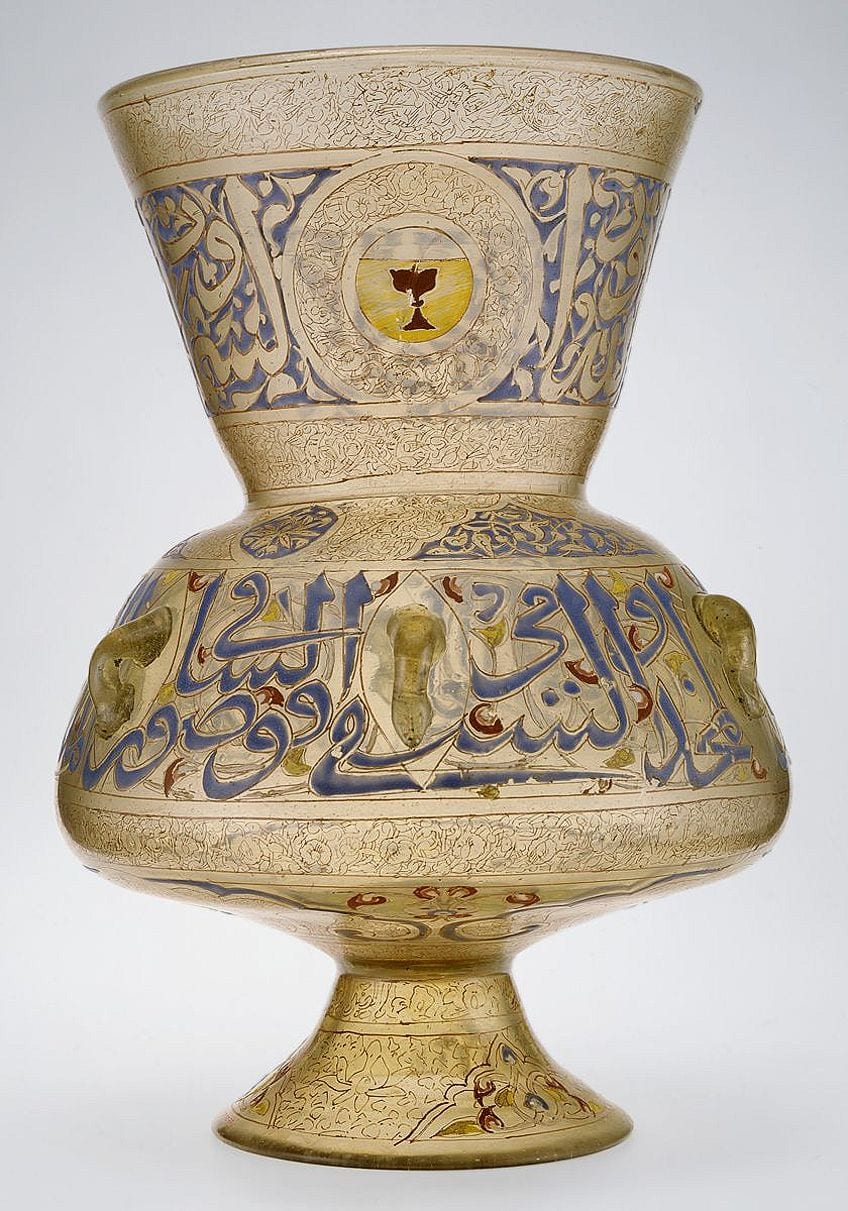 Mosque Lamp of Amir Qawsun, c. 1329 to 1335;The Metropolitan Museum, CC0, via Wikimedia Eatables
Mosque Lamp of Amir Qawsun, c. 1329 to 1335;The Metropolitan Museum, CC0, via Wikimedia Eatables
Islamic Metalwork
Islamic metalwork was primarily made from steel, contumely, or statuary. The types of items fabricated varied from common household items of more fundamental and functional purposes to other items utilized for luxury purposes, which would have been produced for the court. The range of items included bowls, buckets, ewers, incense burners, braziers, candle holders, lamp stands, plates, and more than.
Items would often be made from silver, which indicated a higher condition and was influenced by the before Roman and Byzantine eras. Common items would exist made from brass.
Examples of these argent items include 2 silver plates made in Constantinople. They are titled Plate with David Anointed past Samuel (629 to 630 CE) and Plate with David Slaying a Lion (629 to 630). These describe biblical scenes and were probably created for display at banquets. These Islamic art pieces are examples of items that were used to showcase higher status and wealth.
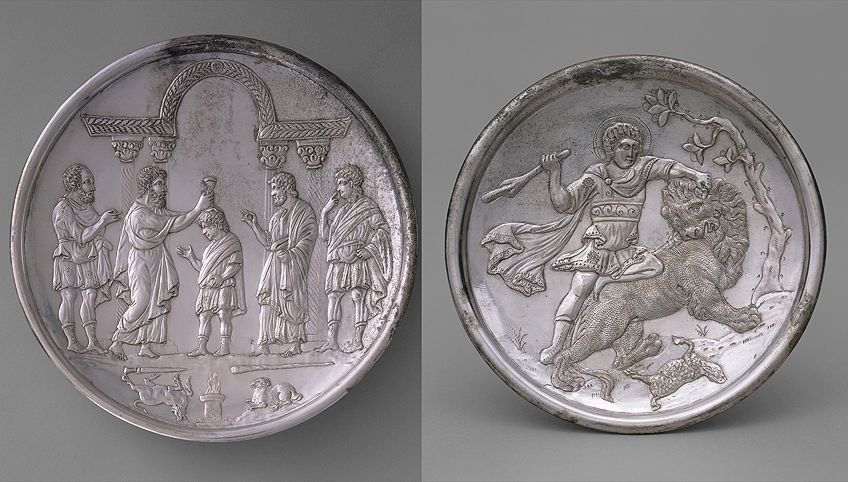 LEFT: Plate with David Anointed by Samuel, 629-630;Metropolitan Museum of Art, CC0, via Wikimedia Commons | RIGHT: Plate with David Slaying a Lion, 629-630; Metropolitan Museum of Fine art, CC0, via Wikimedia Commons
LEFT: Plate with David Anointed by Samuel, 629-630;Metropolitan Museum of Art, CC0, via Wikimedia Commons | RIGHT: Plate with David Slaying a Lion, 629-630; Metropolitan Museum of Fine art, CC0, via Wikimedia Commons
Islamic metalwork items would also be elaborately decorated, and some would have inlays of gold and silver. Such an case is the Baptistère de Saint Louis (1320 to 1340), which is a basin made of hammered contumely with inlays of black niello, golden, and silverish. This basin was made during the Mamluk period by the artist Muhammad ibn al-Zayn. The above basin depicts inner and outer friezes of various figural and foliage forms, with notable riders on horses who appear to be in the process of hunting while other figures are standing without accompanying horses.
Other metalwork items would have an array of different subject matter, ranging between foliage, animals, Zodiac signs, and the feature calligraphy and Arabesque patterns typical of Islamic art.
Other items, such equally the 8thcentury CE Brazier, depicted figural shapes like women, satyrs, and birds – subject area matter of a Dionysiac nature. This Brazier was the property of the wealthy bully-grandson of 'Uthman ibn 'Afan, the third ruling Caliph.
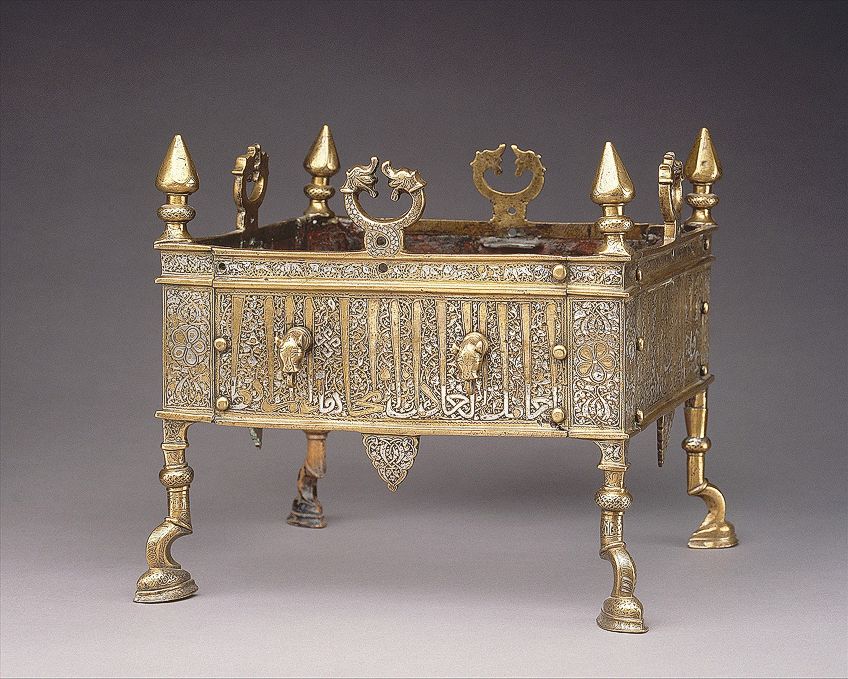 Brazier of Sultan al-Malik al-Muzaffar Shams al-Din Yusuf ibn 'Umar, the second half of the 13th century; Metropolitan Museum of Art, CC0, via Wikimedia Commons
Brazier of Sultan al-Malik al-Muzaffar Shams al-Din Yusuf ibn 'Umar, the second half of the 13th century; Metropolitan Museum of Art, CC0, via Wikimedia Commons
Another example includes the Chapeau of an Incense Burner (viiithursday century CE), which was excavated in Jordan at Umm al-Walid. Information technology is cast from statuary with piercings and engravings. The patterns are formed from bands that run diagonally, making foursquare shapes with open motifs inside these shapes.
Other household items include various ewers and beakers, such every bit the silver Ewer with Dancing Females Inside Arcades (6th to seventhursday century CE). Here, nosotros see various Dionysiac elements, especially the female figure and various animals with festivity-related objects surrounding her. The ewer itself is ornamental in nature and would have served the purpose of a vessel for wine for festivals or religious occasions. This vessel is from the Sasanian period and originated in Islamic republic of iran.
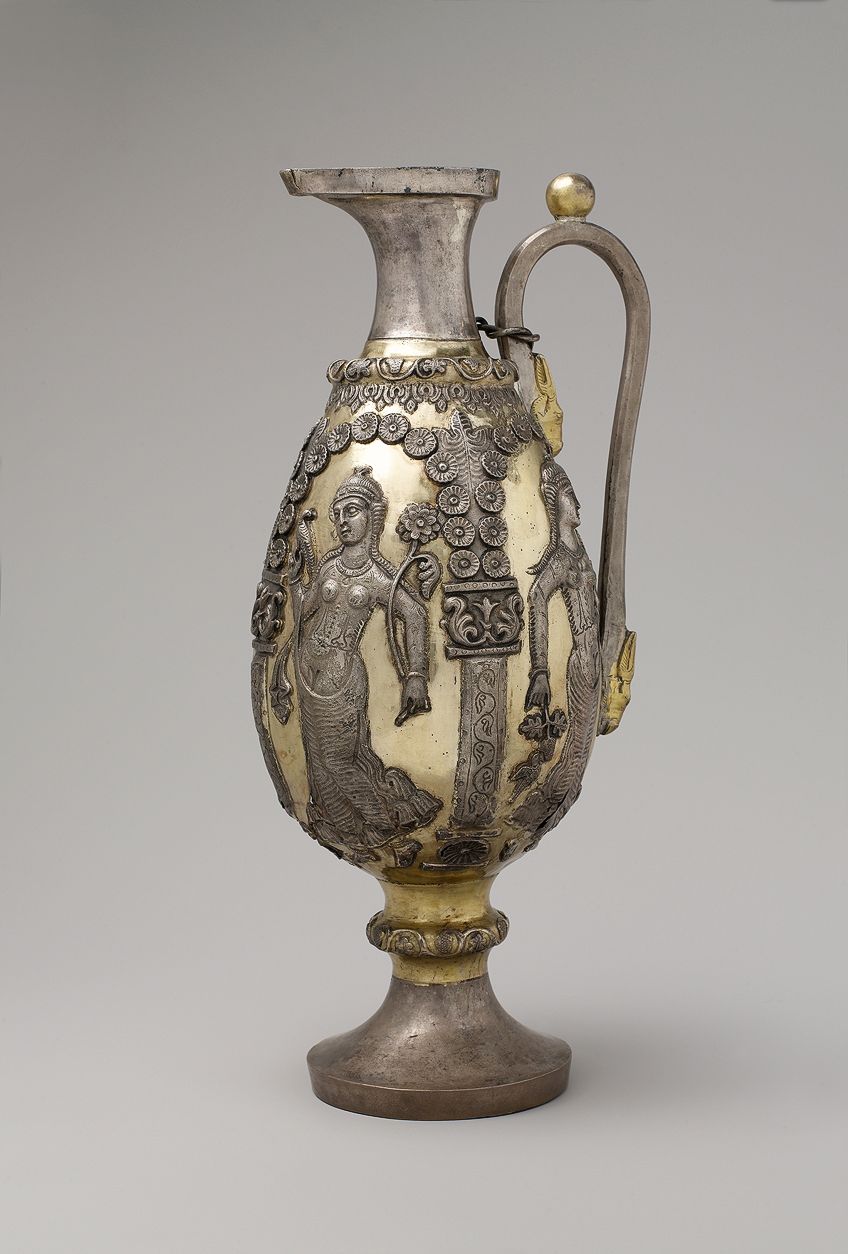 Ewer with dancing females within arcades, c. sixth–7th century Advertisement;Metropolitan Museum of Art, CC0, via Wikimedia Eatables
Ewer with dancing females within arcades, c. sixth–7th century Advertisement;Metropolitan Museum of Art, CC0, via Wikimedia Eatables
Bucket with a Hunting Scene (6th century CE) is made from contumely and depicts animals in the act of hunting. In that location is an inscription in Greek on this bucket, which would have been used for domestic purposes like bathing. The inscription reads, "Utilise this in good wellness, master, for many proficient years happily". The bucket was made in the Eastern Mediterranean.
Similarly, some other functional object, this ewer (bandage from bronze in the 9th century CE) depicts delicate ornamental foliate roll shapes on the bulbous body, reminiscent of the Sasanian menstruum. This vessel is believed to have been made either in Iran or Iraq.
 Ewer inscribed with name and titles of Abu Mansur Izz al-Amir al-Bakhtiyar ibn Muizz al-Dawla, Buyid period, Iran, 3rd quarter of 10th century AD;Daderot, CC0, via Wikimedia Eatables
Ewer inscribed with name and titles of Abu Mansur Izz al-Amir al-Bakhtiyar ibn Muizz al-Dawla, Buyid period, Iran, 3rd quarter of 10th century AD;Daderot, CC0, via Wikimedia Eatables
Some items were also signed by the artist, such equally the Ewer, Signed past Ibn Yazid (c. 688/689 or 783/784 or 882/883). This is cast from a copper blend and made in Iraq. The inscription is noticeable along the rim of the vessel, written in Arabic in the Kufic script. It reads:
"Blessings to he who fashioned it, Ibn Yazid, part of what was fabricated at Basra in the year threescore-nine".
The vessel'due south handle is highly decorative and ascribed to the late-Sasanian period. Information technology has an oval-like or pear-shaped torso, a narrow cervix that flares out into the opening, and a base that narrows as it becomes the trunk. The patterns are too reminiscent of the Byzantine style; we notice the light vertical bands on the main role of the vessel's body.
Islamic Art: From the Past to the Nowadays
Traditional Islamic fine art started to develop over time with more influence from European styles, which is estimated to accept occurred during the 18th century CE. However, Islamic fine art is not only housed in mosques and illuminated manuscripts, but information technology is also alive and well in our contemporary civilisation.
Muslim artists now produce Islamic art with the aim to connect the by to the present and keep the veneration of the Islamic religion and God alive. We meet this in many contemporary exhibitions housing Islamic paintings from the Middle East. An example is from the Islamic Art Now: Contemporary Art of the Middle E exhibition at the LACMA art museum in the U.s.a.. It has been one of the biggest exhibitions showcasing the works of hundreds of Middle East artists and their perspectives.
Islamic art has been effectually for centuries and is equally vast in its style and modalities as it is in the regions it developed in. We can almost say that it has been all around the world and come round total circle – it always returns to what is most valued, and that is the Islamic manner of life, the path to God, and living in award and accord to what is right.
Islamic fine art is a testament to the deeper aspects of the Islamic civilisation, and Muslim artists take left the world with an array of examples, whether it is Islamic cartoon, calligraphy, painting, diverse household objects, or architecture, these all express deeper truths and values.
Oft Asked Questions
What Is Islamic Art?
Islamic art is the term used to designate the arts from the Islamic earth that originated during the viith century CE, although the term was showtime used during the 19thursday century CE. It describes the art, architecture, and various other forms of arts and crafts from the Islamic culture that expert the Islamic religion. It is as well used to designate art forms unrelated to the Islamic religion, but that withal comes from the Islamic civilisation.
What Are the Characteristics of Islamic Fine art?
Some of the main characteristics of Islamic art include the veneration of the holy text called the Qur'an and the messages from the Prophet Mohammad. This is a significant influencing cistron in what drove Muslim artists to produce artwork, although it was not the sole contributing factor. Other characteristics include the dominant geometric shapes used as decorations, chosen Arabesques. Islamic paintings would often not depict figural elements like humans and animals, and calligraphy was also a big function of Islamic art and seen widely as a decorative reminder of the Islamic faith.
When Did Islamic Art Occur?
Islamic art is ordinarily viewed in three chronological divisions. These provide an easier understanding not only of historical accounts just also of how the Islamic World evolved over fourth dimension, artistically and culturally. The chronological society is every bit follows: the Early Catamenia, which occurred from effectually 640 to 900 CE; the Medieval period, which occurred from around 900 to 1517 CE; and the final, or Later period, which occurred from around 1517 to 1924 CE.
stallingstheethem.blogspot.com
Source: https://artincontext.org/islamic-art/
0 Response to "What Role Did Quran Play on Islamic Art and Architecture in Muslim World"
Enviar um comentário